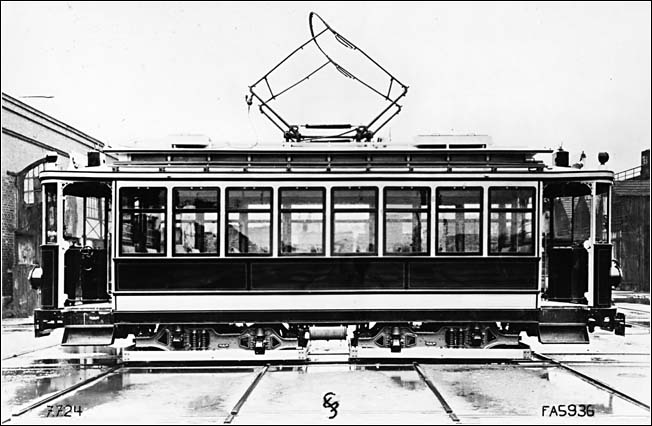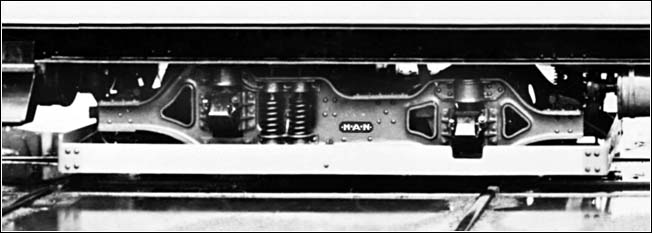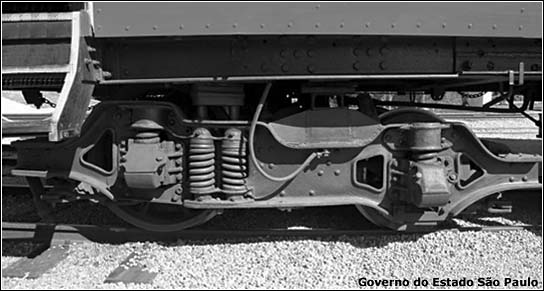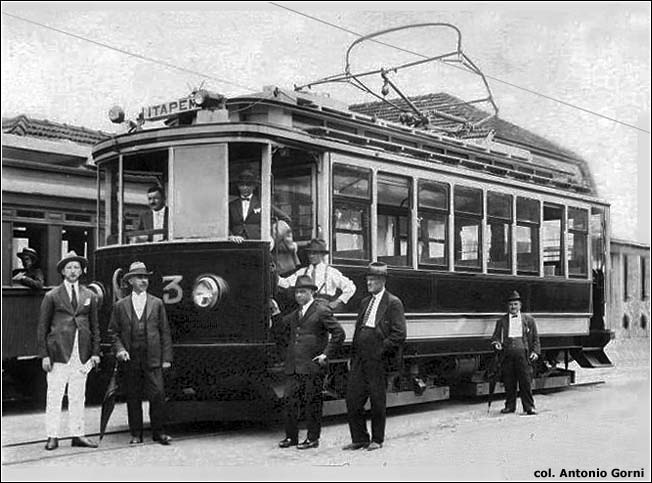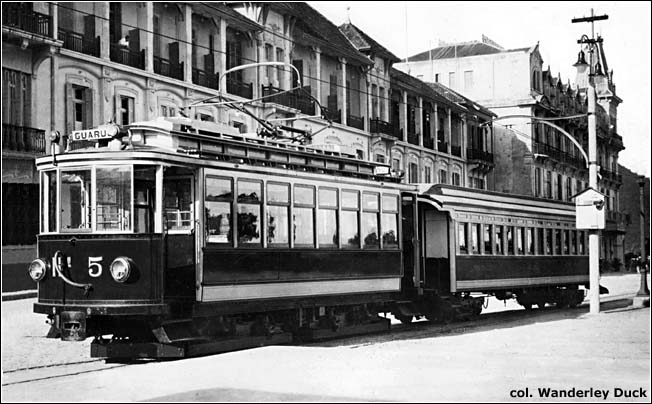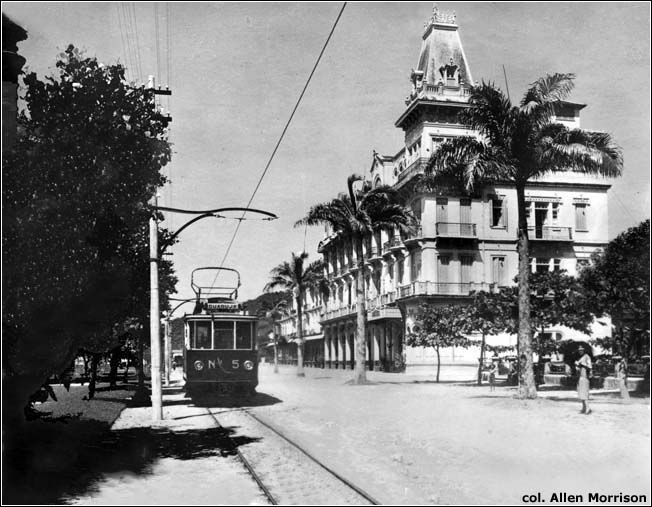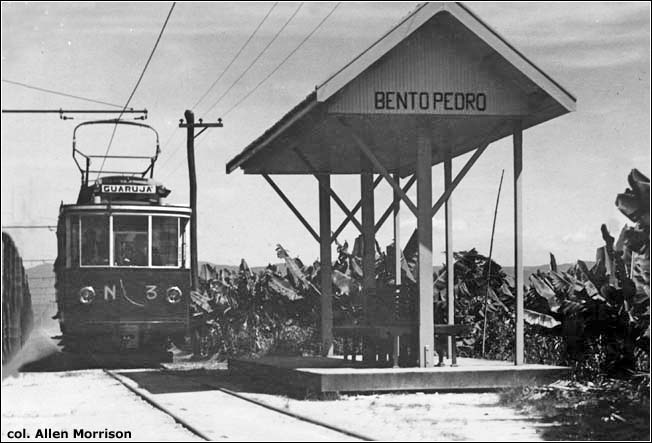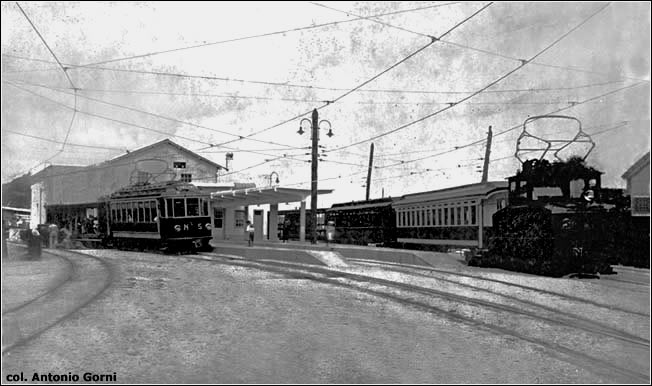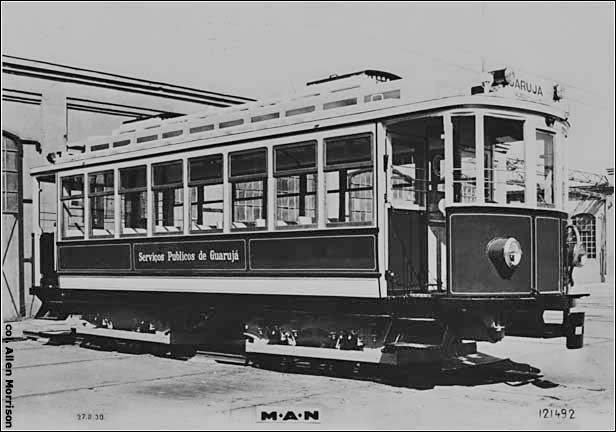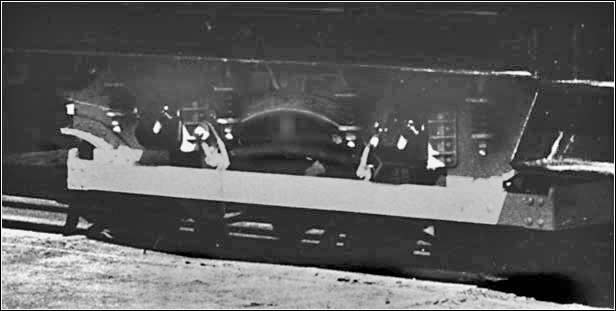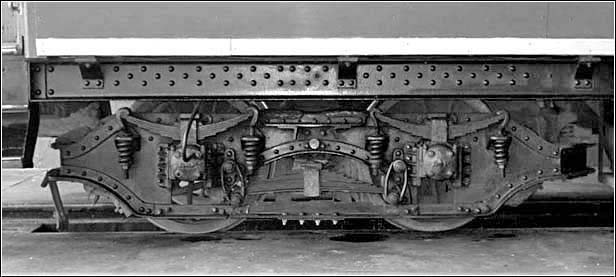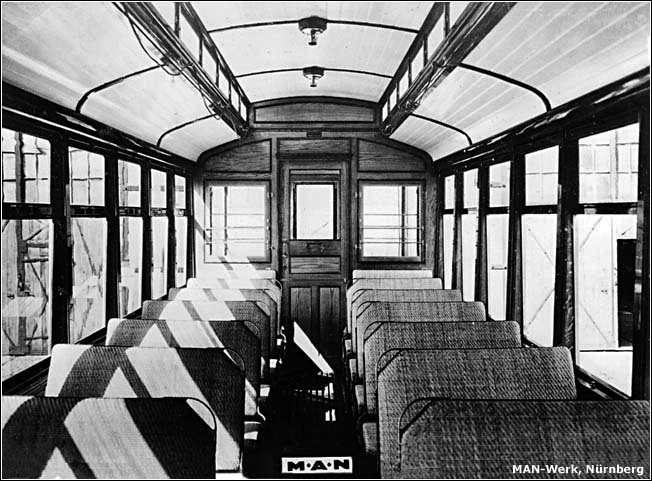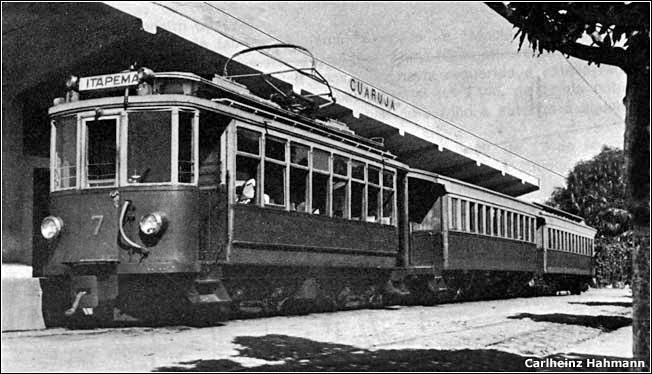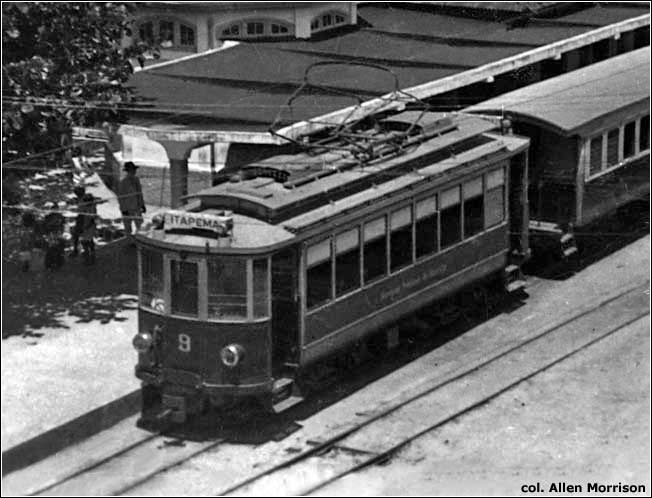G U A R U J Á
São Paulo state
BRAZIL
BY
Allen Morrison
The Portuguese established their first settlement in Brazil in the coastal city of São Vicente, in São Paulo state, in 1532 [see map]. The region developed rapidly and nearby Santos became South America's busiest port. But Santo Amaro Island, directly across the channel from Santos, remained virtually uninhabited for the next 360 years. The land was marshy and access was difficult. There were no bridges. There are still none today. In 1892, with the development of the oceanfronts in Rio de Janeiro, Santos and other cities, a group of entrepreneurs formed the Companhia Balneária da Ilha de Santo Amaro and built a luxury hotel on crescent-shaped Pitangueiras Beach in what today is Guarujá. They also built the transportation facilities to reach it. CBISA acquired three Baldwin locomotives from the Engenho Central Paulista in Porto Feliz (near Sorocaba), purchased an assortment of passenger coaches, and inaugurated a 9 km meter-gauge railway between Itapema (today called Vicente de Carvalho) and Guarujá on 2 September 1893 [see 1923 map of Guarujá and 1938 map of the entire railway line]. Boats ferried passengers across the estuary. The postcard view below shows a train approaching the station in Guarujá. The ocean is behind the station. That's the 220-room Grand Hôtel de la Plage on the left [col. AM]: |

The original 1893 hotel burned in 1897 and was replaced by a smaller hotel. The Companhia Guarujá, which absorbed the Companhia Balneária in 1901, demolished it and built a third hotel in 1912. It is the 1912 hotel, largely financed by the U.S. industrialist Percival Farquhar, that is seen above and in other pictures on this page. Two steam railroads nearby – the E. F. Votorantim in Sorocaba and the Companhia Paulista in Campinas – began electrifying their lines in 1922. The Companhia Guarujá announced in 1923 that it would do the same and signed a contract with Casa Siemens in São Paulo, agent for Siemens-Schuckertwerke in Berlin. CG began reconstruction and ordered rolling stock from Maschinenfabrik Augsburg-Nürnberg in Germany: a 2-axle electric locomotive and two 4-axle electric trams, with maximum traction trucks, each seating 36 passengers [col. AM]: |

("Strassenbahn" = Street Railway; "P.M." = Personen-Motorwagen; "M.D." = Maximum-Drehgestell; "L." = Lokomotive.) The photograph below shows the locomotive at the MAN factory in Germany in 1924 [Siemens-Museum, München; courtesy Wolfgang-D. Richter]:
|

The picture below of one of the passenger cars was taken at the MAN factory on 7 July 1924. The entwined "SS" logo stands for Siemens-Schuckertwerke [Siemens-Museum, München; courtesy Wolfgang-D. Richter]:
Guarujá's two passenger cars were numbered 3 and 5 (the even numbers were apparently reserved for the earlier passenger coaches). Here is number 3 at Guarujá terminus [see map] [col. Antonio Gorni]:
And here is tram number 5. Like the photograph above of the locomotive, this picture was reproduced in the 5 February 1925 edition of the transport journal Brazil-Ferro-Carril. That's the 1912 hotel in the background [see map] [col. Wanderley Duck]:
The postcard below shows number 5 passing the hotel in the late 1920s. View is west. The car is signed "Guarujá" so is apparently going away from the camera toward the station, which is beyond the hotel [col. AM]:
Car 3 traveling south at Bento Pedro, 5 km south of Itapema, 4 km north of Guarujá [see map] [postcard, col. AM]:
The 1912 hotel in Guarujá was never profitable and a new ferryboat service that opened in 1918 from Ponta da Praia in Santos brought automobile and bus competition to the railway [see map]. In an effort to improve service, Serviços Públicos de Guarujá ordered two more trams from MAN in 1930. Numbered 7 and 9, they had conventional bogie trucks and a door with a small window in the front – a design very different from that of cars 3 and 5 [MAN, col. AM]:
This postcard shows car 9 at the original beach terminal [col. AM]:
|

The Latin American Transportation Survey published by the U.S. Government in 1942 [see BIBLIOGRAPHY, below] reported 6 motor cars and 13 trailers running on 8.630 km of meter-gauge track in Guarujá. Unless the "6 motor cars" figure is an error, it seems that the railway acquired more electric equipment. But its origin is unknown.
Automobile and bus competition increased and the railway closed on 13 July 1956. The equipment was sold to the Estrada de Ferro Campos do Jordão, which still operates much of it today. Guarujá tram 5, built in 1924, and numbers 7 and 9, built in 1930, have become Campos do Jordão trams A-7, A-5 and A-6, respectively. The Grande Hotel was demolished in 1960. Avenida Santos Dumont was built over the tram route between Itapema and Guarujá and a completely new diesel-powered railroad, for freight use only, double gauge of 1000/1600 mm, opened parallel to the highway in the 1970s. Baldwin steam locomotive number 2 from the original 1893 railway is preserved today in Guarujá [see 2003 photo by Antonio Gorni]. The photograph below shows Pitangueiras Beach in 2009 ["2( L.L.K. )2", Wikipedia Commons]: |

The Guarujá railway has been gone a half century. But it still fascinates today. It was an isolated line, without connection – or even proximity – to any other railway. It disappeared too early to be known by today's generation of rail enthusiasts, and therefore there are no photographs and there is little knowledge of its final years of operation. Why was tram 3, almost new, scrapped after an "accident"? What was the nature of the accident? The car had maximum-traction trucks, unique in Brazil. Were they saved? Some of the Guarujá equipment still runs today in Campos do Jordão, where it has been rebuilt and renumbered almost beyond recognition. It is hoped that this webpage will inspire further research.
BIBLIOGRAPHY "Electricidade: Viação electrica" in Brazil-Ferro-Carril (Rio de Janeiro), 5 II 1925, p. 143. Description of the new electric railway installation at Guarujá. Photographs of the locomotive and tram 5 (both reproduced on this page). Maschinenfabrik Augsburg-Nürnberg A.G. Strassenbahnwagen: Ergänzung zum Lieferverzeichnis D 12253. Nürnberg, 1928. Alphabetical list, by city, of trams delivered between 1912 and 1928. [Author/publisher unknown] Planta da cidade de Santos - 1938. Area map shows the Itapema-Guarujá railway and branch to Sítio da Cachoeira. [copied at Library of Congress, Washington] United States. Bureau of Foreign & Domestic Commerce. Latin American Transportation Survey - Railway Section: Railways of Brazil, by Seymour T. R. Abt. Washington, 1942. Brief data for the tramway operated by Serviços Públicos de Guarujá, p. 230. "O último trem para Guarujá" in O Estado de São Paulo (São Paulo), 12/7/1956. Announcement that railway service will end that day. [Other sources say 13/7/1956.] Charles A. Gauld. The Last Titan. Percival Farquhar: American Entrepreneur in Latin America. Stanford (California), 1972. Farquhar laments the failure of his Guarujá hotel, pp. 235 and 268. Waldemar Corrêa Stiel. História dos Transportes Coletivos em São Paulo. São Paulo, 1978. The "Guarujá" chapter on pp. 288-292 provides extensive data on the ferryboats and steam railway fleet. But some of his statements about the electric railway are confusing – notes only two electric trams, etc. Allen Morrison. The Tramways of Brazil: A 130-Year Survey. New York, 1989. The Guarujá chapter, pp. 138-140, includes history and two illustrations. The route is shown on the Santos map, p. 134. Since publication, the data on the Campos do Jordão renumbering has been found to be incorrect. Nestor Goulart Reis Filho. Histórias e lendas de Guarujá: O faroeste era logo ali. 2002. History of the town and its railway. Details and pictures of the three hotels. Antonio Gorni. A Eletrificação nas Ferrovias Brasileiras: Companhia Guarujá. 2002. Excellent overall survey of the development and operation of the electric railway. Antonio Gorni. Companhia Guarujá. Companion page to the preceding: 17 enlargeable photographs, mostly of the electric line. Marcelo Tálamo. Companhia do Guarujá: O Tramway que ligou Santos e o Guarujá. 2008. Detailed description of the railway, with links to many photographs, both old and new. [This site has been archived by OoCities.org and may not always be available.] Tramway do Guarujá. 2009. Wikipedia page that copies the data presented in the Gorni and Tálamo pages listed above.
In addition to the works named above, the author is indebted to Ayrton Camargo e Silva in Campinas; Wanderley Duck, Marcelo Tálamo and Nicholas Burman in São Paulo; Antonio Gorni in São Vicente; Kurt Werkmann of Maschinenfabrik Augsburg-Nürnberg in Nürnberg; Wolfgang-D. Richter in Berlin; and the Siemens-Museum in München.
See also See my index of If you have comments, criticism or suggestions, This site was placed online on Copyright © 2012-2112 Allen Morrison |

